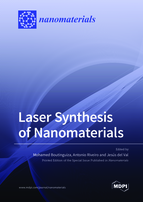Laser Synthesis of Nanomaterials
A special issue of Nanomaterials (ISSN 2079-4991). This special issue belongs to the section "Synthesis, Interfaces and Nanostructures".
Deadline for manuscript submissions: closed (30 April 2021) | Viewed by 44618
Special Issue Editors
Interests: laser materials processing (ablation, cutting, texturing, etc.); laser processing of biomaterials; laser synthesis and deposition of nanomaterials
Special Issues, Collections and Topics in MDPI journals
Interests: laser processing; laser welding; laser cutting; laser cladding; laser texturing; laser surface treatments; laser microprocessing; laser drilling; laser-based additive manufacturing; biomaterials; nanomaterials
Special Issues, Collections and Topics in MDPI journals
2. LaserON Laser Applications Research Group, University of Vigo, Industrial Technological Research Centre - MTI, Rúa Maxwel, 36310 Vigo, Spain
Interests: laser materials processing; laser surface modification; laser micro-cladding; laser micro-texturization; bioactive glasses processing and characterization; nanoparticle production by laser ablation
Special Issues, Collections and Topics in MDPI journals
Special Issue Information
Dear Colleagues,
Nanomaterials are one of the main topics of research at present. These materials, with at least one of their dimensions in the nanoscale (i.e., in a length range from 1 nm to 100 nm) have remarkable or unconventional properties compared to bulk materials. These materials are currently used in many applications; however, new potential uses are being investigated. In this sense, there is a large interest in their use in medicine, electronic devices, production and storage of energy, composite materials, etc. The production of nanomaterials is addressed through physical and/or chemical methods; however, most of these methods exhibit low reproducibility or a low production rate or make use of toxic chemicals. In order to avoid most of these drawbacks, laser-based synthesis of nanomaterials has emerged as an alternative to overcome these limitations. This family of methods uses a laser beam to produce different nanomaterials (e.g., nanoparticles, nanowires or 2D materials) using diverse approaches. Techniques such as those based on laser ablation, laser vaporization, pulsed laser deposition (PLD), laser–chemical vapor deposition (LCVD), etc. are being explored, at present, to fabricate these nanoscale materials with a controlled size and shape. In this context, the present Special Issue will include research papers addressing the most recent developments in this field to summarize the current state-of-the-art in the synthesis of nanomaterials using laser techniques.
Suitable topics include but are not limited to:
- Laser nanoprocessing;
- Laser ablation techniques, liquid-phase laser ablation;
- Laser-assisted chemical vapor deposition (LCVD);
- Pulsed laser deposition;
- Ultrafast laser synthesis of nanomaterials;
- Laser-Induced Fragmentation.
Prof. Dr. Mohamed Boutinguiza
Dr. Antonio Riveiro
Dr. Jesús del Val
Guest Editors
Manuscript Submission Information
Manuscripts should be submitted online at www.mdpi.com by registering and logging in to this website. Once you are registered, click here to go to the submission form. Manuscripts can be submitted until the deadline. All submissions that pass pre-check are peer-reviewed. Accepted papers will be published continuously in the journal (as soon as accepted) and will be listed together on the special issue website. Research articles, review articles as well as short communications are invited. For planned papers, a title and short abstract (about 100 words) can be sent to the Editorial Office for announcement on this website.
Submitted manuscripts should not have been published previously, nor be under consideration for publication elsewhere (except conference proceedings papers). All manuscripts are thoroughly refereed through a single-blind peer-review process. A guide for authors and other relevant information for submission of manuscripts is available on the Instructions for Authors page. Nanomaterials is an international peer-reviewed open access semimonthly journal published by MDPI.
Please visit the Instructions for Authors page before submitting a manuscript. The Article Processing Charge (APC) for publication in this open access journal is 2900 CHF (Swiss Francs). Submitted papers should be well formatted and use good English. Authors may use MDPI's English editing service prior to publication or during author revisions.
Keywords
- Laser ablation
- Laser synthesis
- Nanoparticles
- Nanofibers
- 2D materials
- Laser-induced fragmentation
- LCVD








